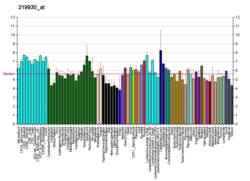Protein-coding gene in the species Homo sapiens
Krueppel-like factor 8 is a protein that in humans is encoded by the KLF8 gene .[ 5] [ 6]
KLF8 has been shown to interact with CTBP2 .[ 7]
van Vliet J, Turner J, Crossley M (May 2000). "Human Krüppel-like factor 8: a CACCC-box binding protein that associates with CtBP and represses transcription" . Nucleic Acids Research . 28 (9): 1955– 62. doi :10.1093/nar/28.9.1955 . PMC 103308 PMID 10756197 . Lossi AM, Laugier-Anfossi F, Depetris D, Gecz J, Gedeon A, Kooy F, Schwartz C, Mattei MG, Croquette MF, Villard L (Feb 2002). "Abnormal expression of the KLF8 (ZNF741) gene in a female patient with an X;autosome translocation t(X;21)(p11.2;q22.3) and non-syndromic mental retardation" . Journal of Medical Genetics . 39 (2): 113– 7. doi :10.1136/jmg.39.2.113 . PMC 1735036 PMID 11836360 . Turner J, Nicholas H, Bishop D, Matthews JM, Crossley M (Apr 2003). "The LIM protein FHL3 binds basic Krüppel-like factor/Krüppel-like factor 3 and its co-repressor C-terminal-binding protein 2" . The Journal of Biological Chemistry . 278 (15): 12786– 95. doi :10.1074/jbc.M300587200 PMID 12556451 . Zhao J, Bian ZC, Yee K, Chen BP, Chien S, Guan JL (Jun 2003). "Identification of transcription factor KLF8 as a downstream target of focal adhesion kinase in its regulation of cyclin D1 and cell cycle progression" . Molecular Cell . 11 (6): 1503– 15. doi :10.1016/S1097-2765(03)00179-5 PMID 12820964 . Zhang P, Basu P, Redmond LC, Morris PE, Rupon JW, Ginder GD, Lloyd JA (2006). "A functional screen for Krüppel-like factors that regulate the human gamma-globin gene through the CACCC promoter element". Blood Cells, Molecules & Diseases . 35 (2): 227– 35. doi :10.1016/j.bcmd.2005.04.009 . PMID 16023392 . Wang X, Zhao J (Jan 2007). "KLF8 transcription factor participates in oncogenic transformation" . Oncogene . 26 (3): 456– 61. doi :10.1038/sj.onc.1209796 PMID 16832343 . Hu JH, Navas P, Cao H, Stamatoyannopoulos G , Song CZ (Mar 2007). "Systematic RNAi studies on the role of Sp/KLF factors in globin gene expression and erythroid differentiation" . Journal of Molecular Biology . 366 (4): 1064– 73. doi :10.1016/j.jmb.2006.12.047 . PMC 1907364 PMID 17224162 . Wang X, Zheng M, Liu G, Xia W, McKeown-Longo PJ, Hung MC , Zhao J (Aug 2007). "Krüppel-like factor 8 induces epithelial to mesenchymal transition and epithelial cell invasion" . Cancer Research . 67 (15): 7184– 93. doi :10.1158/0008-5472.CAN-06-4729 PMID 17671186 .
(1) Basic domains
(1.1) Basic leucine zipper (bZIP )(1.2) Basic helix-loop-helix (bHLH )
Group A Group B Group CPAS Group D Group E Group F
(1.3) bHLH-ZIP (1.4) NF-1 (1.5) RF-X (1.6) Basic helix-span-helix (bHSH)
(2) Zinc finger DNA-binding domains
(2.1) Nuclear receptor (Cys4 )
subfamily 1 subfamily 2 subfamily 3 subfamily 4 subfamily 5 subfamily 6 subfamily 0
(2.2) Other Cys4 (2.3) Cys2 His2 (2.4) Cys6 (2.5) Alternating composition (2.6) WRKY
(4) β-Scaffold factors with minor groove contacts
(0) Other transcription factors




